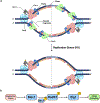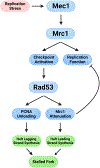Rad53 arrests leading and lagging strand DNA synthesis via distinct mechanisms in response to DNA replication stress
- PMID: 35778827
- PMCID: PMC10316031
- DOI: 10.1002/bies.202200061
Rad53 arrests leading and lagging strand DNA synthesis via distinct mechanisms in response to DNA replication stress
Abstract
DNA replication stress threatens ordinary DNA synthesis. The evolutionarily conserved DNA replication stress response pathway involves sensor kinase Mec1/ATR, adaptor protein Mrc1/Claspin, and effector kinase Rad53/Chk1, which spurs a host of changes to stabilize replication forks and maintain genome integrity. DNA replication forks consist of largely distinct sets of proteins at leading and lagging strands that function autonomously in DNA synthesis in vitro. In this article, we discuss eSPAN and BrdU-IP-ssSeq, strand-specific sequencing technologies that permit analysis of protein localization and DNA synthesis at individual strands in budding yeast. Using these approaches, we show that under replication stress Rad53 stalls DNA synthesis on both leading and lagging strands. On lagging strands, it stimulates PCNA unloading, and on leading strands, it attenuates the replication function of Mrc1-Tof1. We propose that in doing so, Rad53 couples leading and lagging strand DNA synthesis during replication stress, thereby preventing the emergence of harmful ssDNA.
Keywords: ATR; DNA replication; DNA replication checkpoint; Mec1; Rad53; eSPAN; strand-specific sequencing.
© 2022 Wiley Periodicals LLC.
Figures


Comment in
-
Keeping the strands together: Rad53 regulation of fork symmetry promotes replication stability.Bioessays. 2022 Sep;44(9):e2200141. doi: 10.1002/bies.202200141. Epub 2022 Aug 15. Bioessays. 2022. PMID: 35971183 No abstract available.
Similar articles
-
A mechanism for Rad53 to couple leading- and lagging-strand DNA synthesis under replication stress in budding yeast.Proc Natl Acad Sci U S A. 2021 Sep 21;118(38):e2109334118. doi: 10.1073/pnas.2109334118. Proc Natl Acad Sci U S A. 2021. PMID: 34531325 Free PMC article.
-
Checkpoint Kinase Rad53 Couples Leading- and Lagging-Strand DNA Synthesis under Replication Stress.Mol Cell. 2017 Oct 19;68(2):446-455.e3. doi: 10.1016/j.molcel.2017.09.018. Epub 2017 Oct 12. Mol Cell. 2017. PMID: 29033319 Free PMC article.
-
Strand-specific analysis shows protein binding at replication forks and PCNA unloading from lagging strands when forks stall.Mol Cell. 2014 Nov 20;56(4):551-63. doi: 10.1016/j.molcel.2014.09.017. Epub 2014 Oct 23. Mol Cell. 2014. PMID: 25449133 Free PMC article.
-
The S-phase checkpoint: targeting the replication fork.Biol Cell. 2009 Aug 19;101(11):617-27. doi: 10.1042/BC20090053. Biol Cell. 2009. PMID: 19686094 Review.
-
Signaling pathways of replication stress in yeast.FEMS Yeast Res. 2017 Mar 1;17(2). doi: 10.1093/femsyr/fow101. FEMS Yeast Res. 2017. PMID: 27915243 Review.
Cited by
-
Checkpoint kinase interaction with DNA polymerase alpha regulates replication progression during stress.Wellcome Open Res. 2023 Jul 26;8:327. doi: 10.12688/wellcomeopenres.19617.1. eCollection 2023. Wellcome Open Res. 2023. PMID: 37766847 Free PMC article.
-
A tale of two strands: Decoding chromatin replication through strand-specific sequencing.Mol Cell. 2025 Jan 16;85(2):238-261. doi: 10.1016/j.molcel.2024.10.035. Epub 2025 Jan 16. Mol Cell. 2025. PMID: 39824166 Review.
-
Revised mechanism of hydroxyurea-induced cell cycle arrest and an improved alternative.Proc Natl Acad Sci U S A. 2024 Oct 15;121(42):e2404470121. doi: 10.1073/pnas.2404470121. Epub 2024 Oct 7. Proc Natl Acad Sci U S A. 2024. PMID: 39374399 Free PMC article.
References
Publication types
MeSH terms
Substances
Grants and funding
LinkOut - more resources
Full Text Sources
Molecular Biology Databases
Miscellaneous

